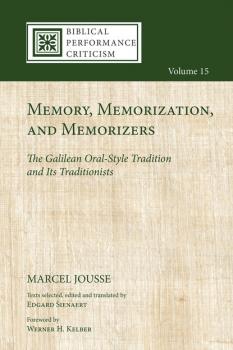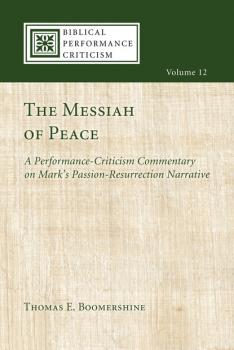Biblical Performance Criticism
Скачать книги из серии Biblical Performance CriticismPerformance Criticism of the Pauline Letters
Receiving a letter from Paul was a major event in the early churches. Given the orally oriented culture of the time, a letter was designed to be read out loud in front of an audience. The document was an intermediate state for the local transport of the message, but the actual medium of communication was the performance event. This event was embedded in the written text in a manner comparable to a theater script. After careful preparation because of high expectations from ancient audiences, a presenter embodied the message with his voice, gazes, and gestures and made it not only understood but jointly experienced. After presenting a short history of performance criticism, this book clarifies what is meant by the highly ambiguous term «performance» and develops steps to analyze ancient texts in order to find and understand the embedded signals of performance. This leads to a critical assessment of the potential of performance criticism as a method. Then, the method is applied to the Pauline Epistles and other early Christian letters. It proves to be highly rewarding: difficult passages become comprehensible, new aspects come to light, the text's impact on the audience is felt–in short, the texts come alive.
The Messiah of Peace
The telling of Mark's story of Jesus as the Messiah of peace in the decades following the Roman-Judean war announced a third way forward for Diaspora Judeans other than warfare against or separation from «the nations.» Mark's Gospel was the story of the victory of a nonviolent Messiah who taught and practiced the ways of a new age of peace and reconciliation in contrast to the ancient and modern myth of redemptive violence.
The Messiah of Peace is a performance-criticism commentary exploring a new paradigm of biblical scholarship that takes seriously the original experience of the Gospel of Mark as a lively story told to audiences rather than as a text read by readers.
The commentary is correlated with the Messiah of Peace website, which features video recordings of the story in both English and Greek. Critical investigation of the sounds of the Markan passion-resurrection narrative reveals the identity of its original audiences as predominantly Judean with a minority of Gentile nonbelievers. Hearing the passion-resurrection story was an experience of involvement in the forces that led to the rejection and death of Jesus–an experience that brought on the challenges inherent in becoming a disciple of the Messiah of peace.
The Story of Naomi—The Book of Ruth
The book of Ruth is probably best known as a romantic love story that, through the expression of loving devotion, overcomes tragedy and ends with the founding of the most famous family in all of biblical Israel. But the book wasn't always this way. In fact, it wasn't a book at all but rather a story told with a very different purpose in mind. Before Ruth, there was the Story of Naomi, a subversive story designed to challenge a male-dominated status quo. Through comedy, sarcastic irony, and unparalleled rhetorical skill the Naomi storyteller holds up for inspection social gender roles and the power of sexuality in a manner that resonates yet today. The Story of Naomi–The Book of Ruth goes behind the literary rendition of the story and recaptures the original oral tale, with script and performance directions that brings to life the humor, tragedy, and transparent honesty shared between the Naomi storyteller and her audience.
From Text to Performance
For the last two centuries biblical interpretation has been guided by perspectives that have largely ignored the oral context in which the gospels took shape. Only recently have scholars begun to explore how ancient media inform the interpretive process and an understanding of the Bible. This collection of essays, by authors who recognize that the Jesus tradition was a story heard and performed, seeks to reevaluate the constituent elements of narrative, including characters, structure, narrator, time, and intertextuality. In dialogue with traditional literary approaches, these essays demonstrate that an appreciation of performance yields fresh insights distinguishable in many respects from results of literary or narrative readings of the gospels.
The Bible in Ancient and Modern Media
This cutting-edge volume has been brought together in honor of Thomas Boomershine, author, scholar, storyteller, innovator. The particular occasion inviting this recognition of his work is the twenty-fifth anniversary of the Society of Biblical Literature's section on The Bible in Ancient and Modern Media (BAMM), which Tom was instrumental in founding. For two and half decades this program unit has provided scholars with opportunities to explore and experience biblical material in media other than silent print, including both oral and multimedia electronic performances. This book explores many, though by no means all, of the issues lifted up in those sessions over the years.
Contributors A. K. M. Adam Adam Gilbert Bartholomew Arthur J. Dewey Dennis Dewey Joanna Dewey Robert M. Fowler Holly E. Hearon David Rhoads Philip Ruge-Jones Whitney T. Shiner Marti J. Steussy Richard W. Swanson
From Orality to Orality
In this groundbreaking work, Bible translation is presented as an expression of contextualization that explores the neglected riches of the verbal arts in the New Testament. Going beyond a historical study of media in antiquity, this book explores a renewed interest in oral performance that informs methods and goals of Bible translation today. Such exploration is concretized in the New Testament translation work in central Africa among the Vute people of Cameroon. This study of contextualization appreciates the agency of local communities–particularly in Africa–who seek to express their Christian faith in response to anthropological pauperization. An extended analysis of African theologians demonstrates the ultimate goals of contextualization: liberation and identity. Oral performance exploits all the senses in experiencing communication while performer, text, and audience negotiate meaning. Performance not only expresses but also shapes identity as communities express their faith in varied contexts. This book contends that the New Testament compositions were initially performed and not restricted to individualized, silent reading. This understanding encourages a reexamination of how Bible translation can be done. Performance is not a product but a process that infuses biblical studies with new insights, methods, and expressions.
The Case for Mark Composed in Performance
Is it possible to make a case that the Gospel of Mark was not composed by a single man from scattered accounts but in a process of people's telling Jesus' story over several decades? And what can we say about the tellers who were shaping this story for changing audiences?
After an introduction showing the groundwork already laid in oral tradition research, the case begins by tracing the Mark we know back to several quite different early manuscripts which continue the flexibility of their oral ancestors. The focus then turns to three aspects of Mark, its language, which is characterized as speech with special phrases and rhythms, its episodes characterized by traditional forms, and its overall story pattern that is common in oral reports of the time.
Finally several soundings are taken in Mark to test the thesis of performance composition, two scenarios are projected of possible early tellers of this tradition, and a conclusion summarizes major findings in the case. Mark's writer turns out to be the one who transcribes the tradition, probably adhering closely to it in order to legitimate the new medium of writing.
Oral and Manuscript Culture in the Bible
Oral and Manuscript Culture in the Bible is the fruit of Professor Loubser's confrontation with how Scripture is read, understood, and used in the Third World situation, which is closer than modern European societies to the social dynamics of the original milieu in which the texts were produced.
The Oral Ethos of the Early Church
To experience the gospel message as first-century people heard it is to move into an oral world, one with very little reliance on manuscripts. The essays in this book explore this oral world and the Gospel of Mark within it. They demonstrate the oral style of Mark's gospel, which suggests that it was composed orally, transmitted orally in its entirety by literate and nonliterate storytellers, and survived to become part of the canon only because it was widely known orally. Women's storytelling also thrived during the first centuries of Christianity. With the transition to manuscript authority beginning in the middle of the second century, women's voices were often minimized, trivialized, or completely omitted in written versions. Further, when the Gospel of Mark was one of four written Gospels these voices were quickly ignored. An ancient audience hearing Mark performed, however, enjoyed a vibrant experience of the gospel message and its urgent call to follow.









